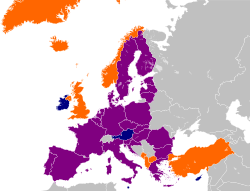
EU member only
NATO member only
member of both
The Berlin Plus agreement is the short title of a comprehensive package of agreements made between NATO and the EU on 16 December 2002. [1] These agreements were based on conclusions of NATO's 1999 Washington summit, sometimes referred to as the "CJTF mechanism" (combined joint task force), [2] and allowed the EU to draw on some of NATO's military assets in its own peacekeeping operations. [3]